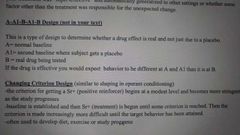![]()
![]()
![]()
Use LEFT and RIGHT arrow keys to navigate between flashcards;
Use UP and DOWN arrow keys to flip the card;
H to show hint;
A reads text to speech;
15 Cards in this Set
- Front
- Back
|
Single-subject designs |
- also known as small N design - the data for each subject is considered independently - used most often in clinical settings to see if treatment is effective for a single individual |
|
|
What is the problem with Large N Designs |
1. Might lack individual subject vailidity 2. Large N could obscure effectiveness |
|
|
3 required elements of a single-subject design |
Since there is no control group behavior must be shown to change as a result of the treatment being used. 1. Operationally define the target behavior 2. Establish a baseline of responding before treatment is introduced 3. Introduce treatment and continue monitoring behavior |
|
|
Simplest Single-subject design |
A (baseline) - B (treatment) design If there is a difference from the initial measured baseline (A) you can assume its because of (B) the treatment |
|
|
What is the problem with A-B Designs? |
There could be other confounding variables that are responsible for the results. Ex. History or maturation |
|
|
Withdrawl (reversal) Design |
A-B-A(withdraw treatment) -(B) bring back treatment If behavior changes correlate with the introduction and removal of treatment its likely that the treatment produced a change. Adding the second B would be to give treatment back to end on a positive note |
|
|
Problems of withdrawal designs: |
A) withdrawal can be unethical B) sometimes withdrawl isnt feasilble like when learning a new skill Altnerative would be to use Multiple-Baseline Design |
|
|
Multiple-Baseline Design |
Baseline measures are established and then treatment is introduced at different times. - unlike ABAB design, treatment is not withdrawn |
|
|
When would you use multiple-baseline design? |
A) to check the same behavior in 2 or more subjects B) two or more behaviors in the same subject C) the same behavior in the same subject but two or more settings |
|
|
Commom characteristics of MBD (mutliple-baseline) |
A) study begins with establishing baselines for each behavior B) treatment for each begins at diff times C) identify this design with several graphs stacked and a dotted line in a stepwiise manner |
|
|
Interpretation problem with MBD |
When changes in behavior treated in one setting, generalize to the other settings and youre no longer sure if its due to the treatment or other factor. |
|
|
A-A1-B-A1-B design |

A is the inital baseline A1 is the placebo baseline < there should not be a change from the inital bc its a placebo B is the real drug < change should occur here A1 is then used as placebo and should go back to baseline End off with B (effective real drug) |
|
|
Changing criterion Design |
The criterion for getting a + Reinforcer is set at modest level but becomes harder as the study progresses until a target behavior is attained. |
|
|
When would you typically use a changing criterion design? |
Develop diet, exercise or study program |
|
|
What are the 5 criticims against single-subject designs? |
1) cannot adequately test for interaction effects 2) study might lack external validity 3) dependent variable is mostly frewuency or rate of response 4) effectiveness of treatment is usually determined by visual insepctionnamd not statistical analysis 5) interpretation problems might ensue if baseline data is unstable or there are pre existing baseline trends |

